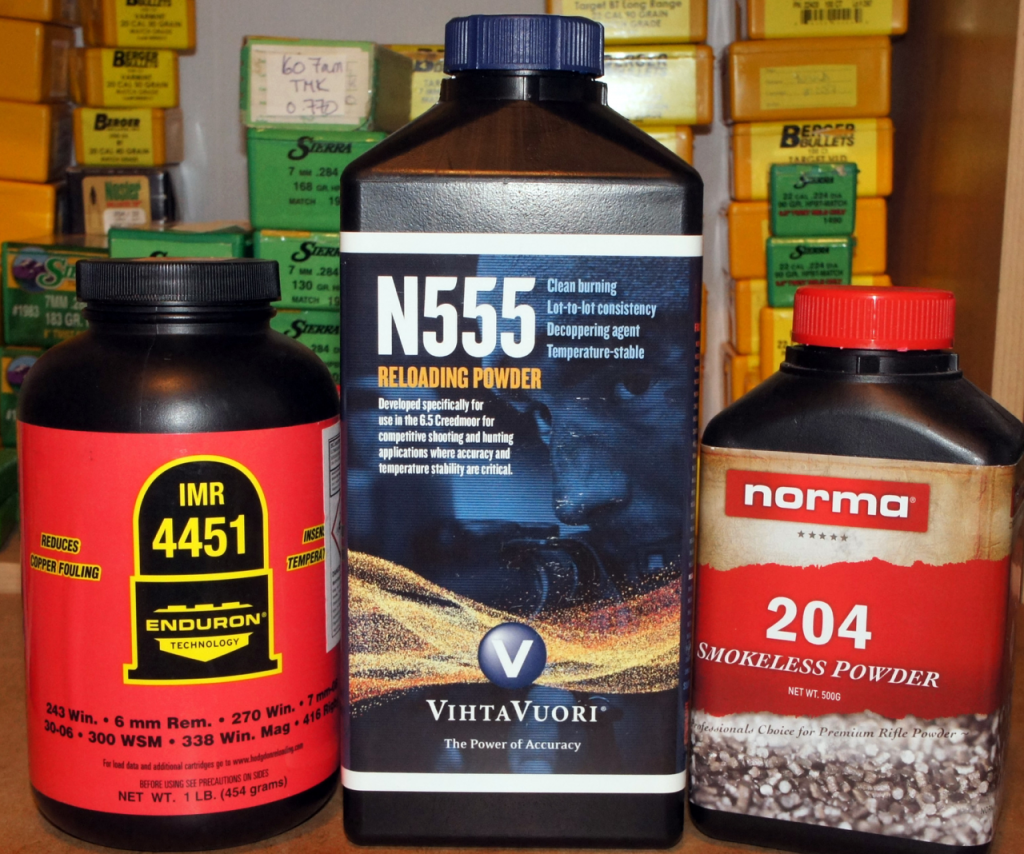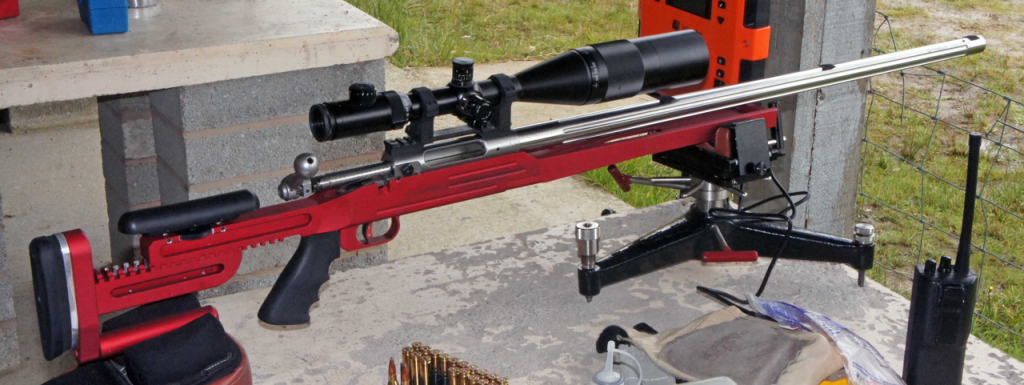
H4350 Alternatives
Continuing with potential alternatives to REACH-banned H4350, (www.targetshooter.co.uk/?p=3624 for the first four grades). Let’s carry on with the next group of five extruded (tubular) powders which I’ve nicknamed ‘The Tortoise and the Hares’, an adaptation of the title of one of the best known of Aesop’s fables from ancient Greece – only in this case, the tortoise doesn’t win the ballistics race. As before, test components were: Lapua cases, PMC LRM primers, 160gn Sierra TMK @ 2.95” COAL (to suit a long-freebore custom match chamber. The rifle has a 31-inch Bartlein 9” twist heavy match barrel.
The Hares sprint away ………….

I categorised results from four of the 13 alternatives to H4350 as ‘Fast Movers’, my top charges producing 50 or more fps than the H4350 benchmark grade’s 2784 fps. They are in reverse place order: Norma URP, Viht N550, with the top slots going to Reload Swiss RS60 / Alliant Re17 and the new Alliant Re16. (There were actually five grades that met the criterion, but I’ll look at Ramshot Hunter separately as a member of a ball powder trio).
Norma URP: Universal?
Norma ‘URP’ only just achieved the plus-50 fps, 43.6gn seeing 2,835 fps. I read somewhere that ‘URP’ is a contraction of Universal Rifle Powder. There is no such thing as ‘universal’ in this context of course, but as far as I can see, the intention was to provide a high performance grade suited to American shooters’ favourites – 243 and 270 Win, 30-06, the 30-cal short magnums and similar, also popular ‘medium size’ European numbers such as 6.5X55, 7×57 and 7X64mm. Norma is unusual in providing the nitro-glycerine values for its products and URP is nearly at the top of the list with 10.5% content by weight, second only to its MRP magnum powder. It’s said by the manufacturer to be slightly faster burning than Norma 204, which would also make it slightly ‘quicker’ than H4350.
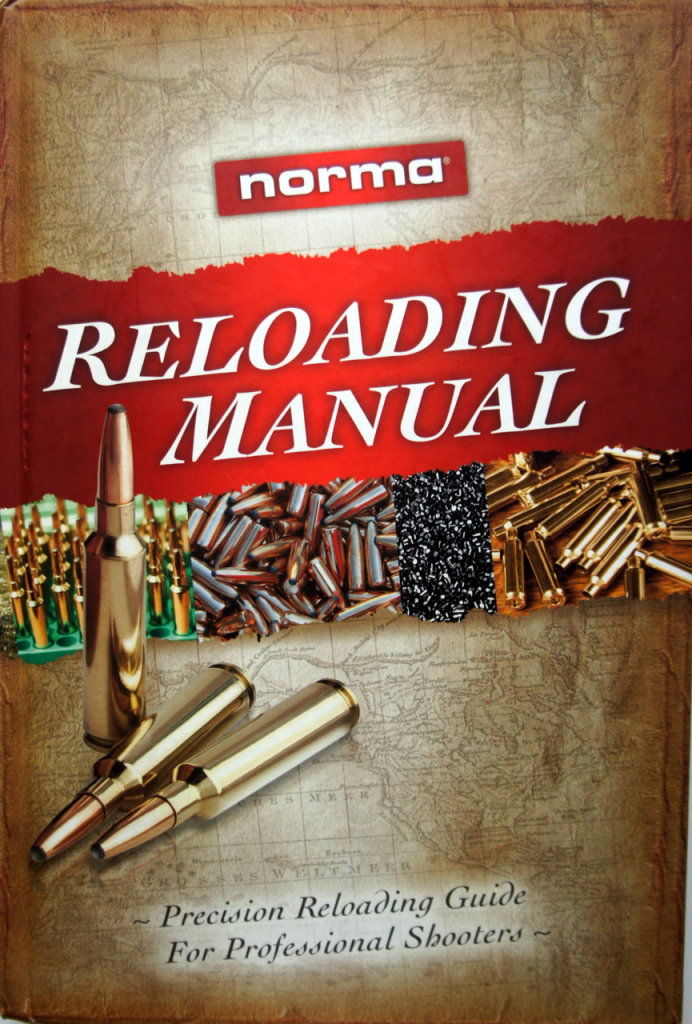
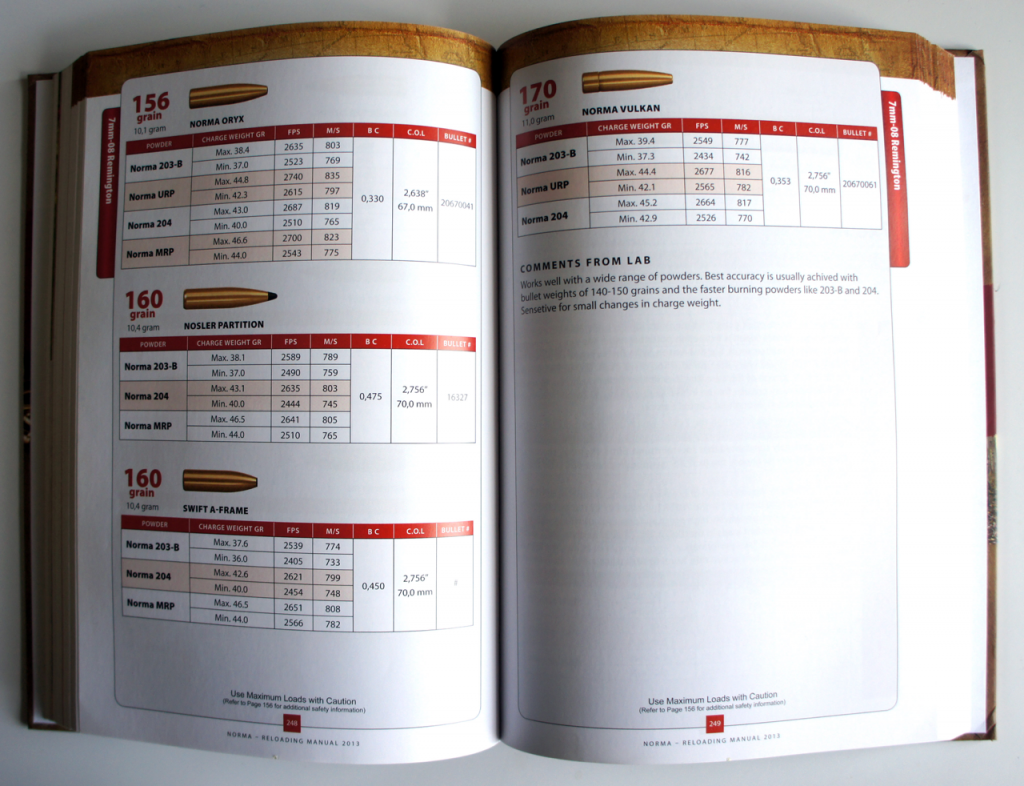
I have Norma’s reloading manual, but its loads weren’t very useful for the 7-08 and the TMK having only a couple of URP combinations, neither with a bullet anything close to equivalent to the Sierra. Norma propellants other than ‘MRP’ magnum powder rarely show up in American reloading manuals, URP not at all. (However, I did subsequently find it listed for a couple of cartridges – 6.5X47 Lapua and 6.5mm Creedmoor in a recently published slim paperback publication from Lyman, the Long Range Precision Rifle Reloading Handbook.

Its maximum charges there were close to, usually marginally below, those for H4350 with MVs considerably higher, and it even picked up a ‘potentially most accurate load’ award for one bullet with each cartridge. However, finding this gem came long after I’d decided on loads for the powder and range-tested it).
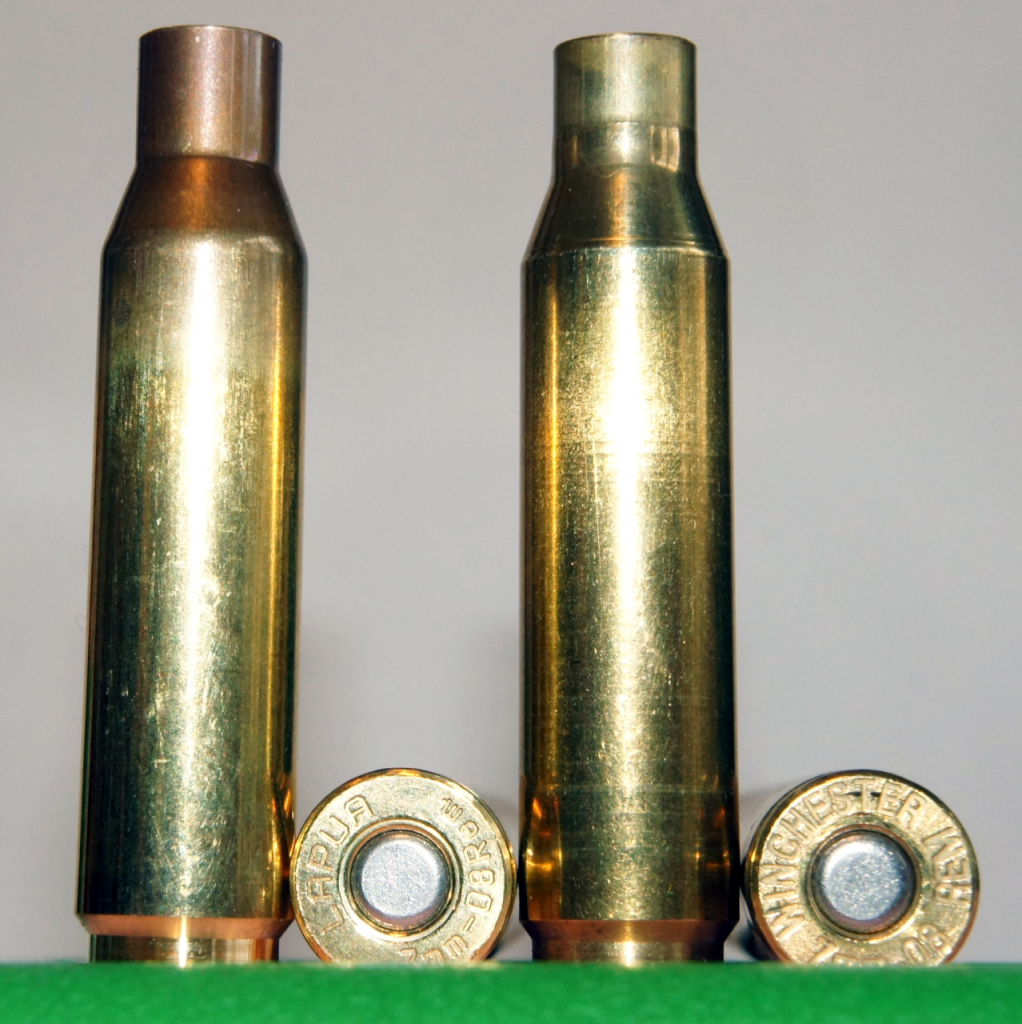
Relying on QuickLOAD for a powder I’d no experience of, I played safe and settled on a top charge of 43.6gn which should have produced 2,770 fps at below 52,000 psi according to the model. In the event, actual MV was some 65 fps higher and PMax would have had to have been up at around 55,000 psi to achieve that. In line with Lyman’s ‘most accurate’ (ie ballistically most consistent) designations in the two 6.5s, ES values were excellent at 5-7 fps. Groups ran at 0.4 – 0.6-inch, very much middle of the road. I was impressed by this first encounter and believe this may turn out to be a good performer in many applications. It is certainly a viable H4350 alternative across a range of cartridges, albeit as Norma says, a bit faster burning.
Vihtavuori N550: Hot Finn
After the new to me URP, next up is a grade I’ve used off and on for a quarter century, Vihtavuori ‘High-Energy’ N550. This is a potentially hot number, the originally nitrocellulose kernels infused with nitroglycerin during the manufacturing process, and is also very much quicker burning than is shown in burning rate charts so far as I can see. Yet again, the first issue was charge weights with a considerable difference between QuickLOAD v.3.6 results and Vihtavuori’s data. QL said I could use H4350’s maximum charge of 45gn and still run at less than 57,000 psi (with the 2.95” COAL); Viht’s maximum (for the standard short chamber) was 41.8gn for the 160gn Sierra SBT GameKing, more than 3gn less! So I loaded examples up to 43.6gn (Viht’s 41.8gn + 1.8gn estimate for the chamber difference), but was prepared to pull the plug on testing should any hint of excessive pressures appear. As it turned out, the actual MV from 43.6gn N550 was 2,856 fps, nearly 90 fps over the QL calculation. According to the QL computation, this MV should have been produced at 45.2gn charge weight which would produce an estimated 57,279 psi peak chamber pressure!
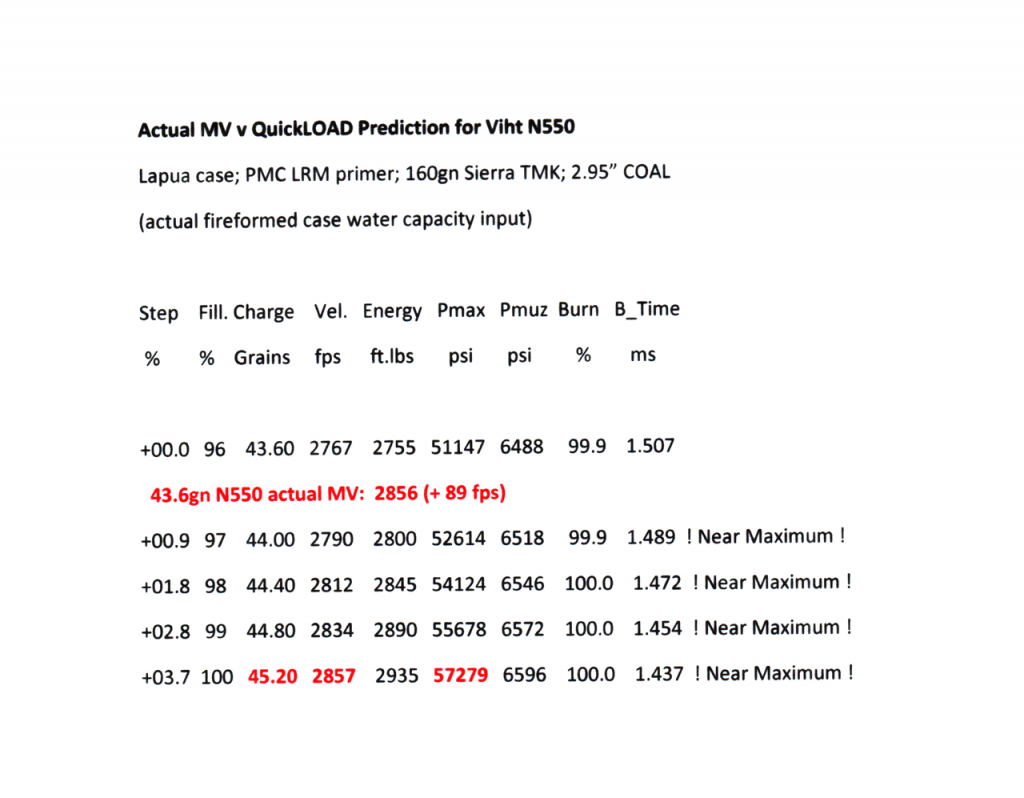
MV ES values were good, but not as good as URP’s, and groups were again reasonable if not outstanding. However far too much of the dispersion was caused by vertical stringing which rarely if ever bodes well for longer distance precision. Despite its position in burning rate charts, N550’s inclusion amongst H4350 alternatives is at best marginal. (I have since tried it in heavy-bullet 223 Rem as a Hodgdon VarGet alternative where it acquitted itself exceptionally well).
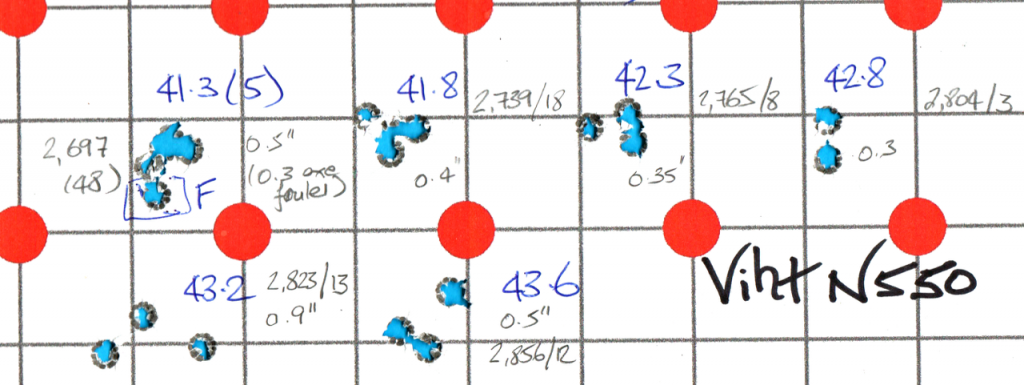
Alliant Re16: ‘TZ Technology’ Wonder
In second (or maybe 1st) place for top MV was the new Alliant Re16 which has quickly become a favourite across the Atlantic – good results with high MVs in cartridges like 6.5mm Creedmoor and 284 Winchester in heavy bullet match loads. With its numerical designation falling between long-established Re15 in the ‘VarGet-class’ and Re17 which is roughly akin to the 4350s, it’s natural – but incorrect – to assume it also falls between this pair in applications and charges. It is a second Alliant grade that is firmly in the ‘4350-class’, and actually appears to be slightly slower burning than its Re17 stablemate in some applications. In the 7mm-08, Sierra gives Re16 a max charge weight of 45.5gn for its 160s and Re17 44.2gn, both listed as producing 2,700 fps in the 24-inch test barrel.
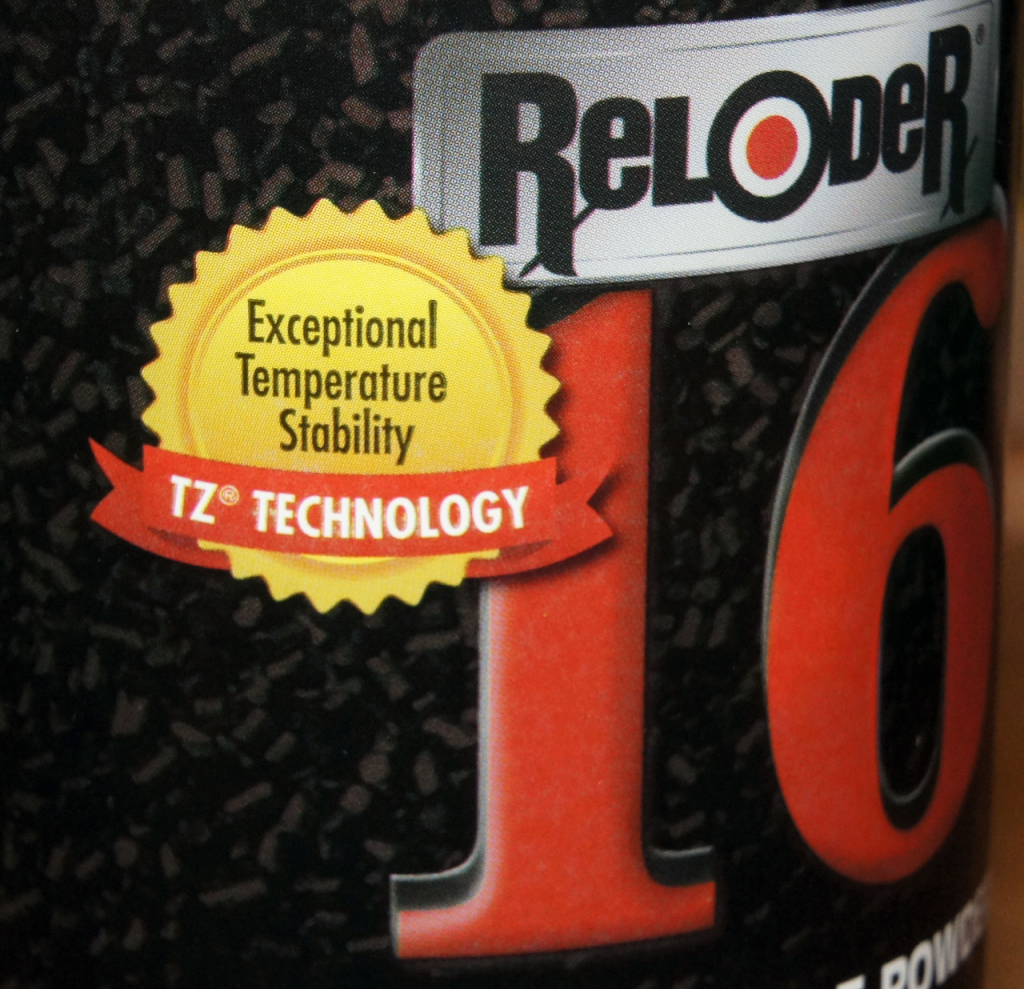
Many also assume that both are made by the same people and wonder why Alliant has adopted two apparently similar same-source powders. This is also a misapprehension – Re16 is one of the new ‘TZ’ grades from Alliant’s traditional rifle propellant supplier, Eurenco Bofors in Sweden. Re17 is a Nitrochemie ‘EI’ infused deterrents product manufactured in Switzerland, and whilst both products employ cutting edge technologies, they’re quite different. Note though, both include nitroglycerin in their formulations. Re16 may not provide quite as high performance as the hot-shot Re17 (Reload Swiss RS60 to us in the UK), but its USP is the ‘TZ Technology’ that makes it very temperature stable in addition to high performance. Rumours from across the Atlantic hint it performs even better than class-leader H4350 in this respect across North America’s huge ambient temperature ranges.

On the range, Re16 lived up to its high-velocity reputation with my starting load of 43gn almost matching 45gn H4350’s MV, and the 45.5gn top charge producing 2,899 fps, or 110 fps higher, also the highest single MV recorded across all powders tried. (These finding are at odds with the Sierra manual’s data-set where 45gn H4350 and 45.5gn Re16 achieve the same 2,700 fps MV – strange!) Again, ES values were reasonable at 9-17 fps, but groups were nothing to write home about at 0.35 to 0.8-inches, four out of the five seeing the dispersion as verticals. This conforms to the pattern where the Savage action and heavy Bartlein hanging off its front dislike the more aggressive powders.
So far as standard SAAMI chamber loads go, Sierra quoted 45.5gn maximum for Re16, but that was in roomy Winchester brass. Do NOT use this charge weight in Lapua cases in a standard SAAMI short chamber with this weight of bullet. One other thing to note is that Re16 is a bulky powder despite being short-cut. 45.5gn was a compressed load here in Lapua brass even with the shallower seated bullet / 2.95-inch COAL. This feature may limit Re16’s usefulness if you’re considering it for cartridges with smaller cases. The aforementioned Lyman Long Range Precision Rifle Reloading Handbook provides Re16 loads for the 6mm and 6.5mm Creedmoors, as does Alliant itself, so you’re fine at this capacity. QuickLOAD’s latest v.3.9 says it’ll likely just be OK in the smaller-case 6.5X47mm Lapua providing an ample freebore chamber allied to shallow seated bullets is employed; maybe barely too, the Dasher variant of the 6mm BR. (Alliant’s latest and faster-burning ‘TZ’ grade, Reloder TS 15.5, looks a better match to these small cartridge designs when it eventually reaches our shores, though).
RS60 / Re17: The Swiss Ferrari
That leaves Reload Swiss RS60, aka Alliant Re17, in this high-performance group. I loaded up eight batches from 42.5 to 45.3gn, four rounds each this time. Strictly speaking, what I loaded was ‘Elcho-17’, its original Nigel Cole-Hawkins marketing name when he bulk-imported the stuff and packaged it up in kilogram lots (cf TR140/RS50 in Part 2). It’s one and the same thing though, whether labelled Elcho-17, Reloder-17, or RS60. On its launch, this propellant quickly gained a reputation for pushing MVs considerably higher than any other powder on the market in some applications, especially heavy bullets in the 6XC Tubb and 284 Win. An element of disillusion followed after a year or two once users discovered there was inevitably a price to be paid for the exceptional velocities – rapid barrel wear if you ‘push’ loads. Once understood, this shouldn’t be an issue – if barrel life is an issue for you, simply keep loads down a grain or three below what the powder actually allows. Sierra lists Re16 and 17 alongside H4350 in its 7mm-08 160gn bullets’ data with all three achieving 2,700 fps in the 24-inch test barrel, maximum charges listed as 45.5, 44.2, and 45.0gn respectively.
Yet again QuickLOAD v.3.6 said you can fill the case in my long-throat set-up before seeing excessive pressures – 46.5gn for 2,940 fps at a high but still safe 58,000 psi it said. ‘Not a chance!’ thought I. (The older version of the program tended to understate pressures and MVs with the RS ‘EI’ grades in my experience, at least using its default settings.) I loaded batches up to 45.3gn, higher than Sierra’s maximum, but still only producing 53,275 psi according to QL. What does the Reload Swiss online data facility (www.propellants.co.uk) say? It only lists loads for heavier match bullets in the cartridge, 162-180gn, at SAAMI COALs, and surprisingly (to me at any rate) provides charges solely for RS50 and 52 powders, usable but on the fast burning side.

On the range, the chronograph external power-feed cable was playing up, (although it was to be much later before this was identified as the problem), and the Labradar tripped out for low voltage after the four charge weights running up to 43.9gn, leaving me ‘blind’ thereafter. 43.9gn was recorded as 2,845 fps – an impressive speed with 1.1gn less powder giving 60 fps more than the benchmark H4350 load.
Going back to QuickLOAD, it had underestimated this charge’s performance by 48 fps, equivalent to 0.8gn worth of powder charge and c.3,000 psi according to the program. However, as each grain increment was actually producing an extra 70 fps or thereabouts MV on the chronograph before I lost it, my top load of 45.3gn would be expected to produce another 100 fps hitting 2,940-2,950 fps, which QL estimates as running at an allowed but high 59,000 psi. Let’s say I was just a little nervous as I fired the next four batches without the ability to see the actual MVs being produced, carefully feeling the bolt handle up after each shot looking for resistance, scanning the case-head and primer for high-pressure signs. Of those there were none, and although getting into ‘dicey practices’ here, it’s as well I carried on as HM Government caught another severe dose of the dreaded Covid-Pandemic-Panic condition only days later, and we were locked down again for months immediately afterwards. However, that’s why I was ambiguous about which powder was the numero uno ‘Speed King’. My highest recorded MV was with Re16, but the RS60 / Re17 estimated speed would have comfortably passed it. Do NOT copy this load – stick with Sierra’s 44.2gn maximum in SAAMI chambered rifles, and reduce that too if loading RS60 / Re17 in Lapua brass.
Speed aside, my four chrono’d batches weren’t unduly impressive with 19-25 fps spreads and no group out of the eight fired smaller than 0.4-inch. Not dire, but nothing like as good as the milder grades including RS60’s single-based stablemate RS62 in the Savage PTA-action rifle. I’m pretty sure though, that a stiffer set-up as with my Barnard Model-P action rifles or a suitable BAT, Borden etc would cope better with RS60 and the other more energetic powders.
……. While the Tortoise Plods Along – Lovex SO70

When I undertook my desk research on 4350 alternatives, Lovex SO70 was an obvious choice, it even being marketed as a ‘4350’ at one time (and is now again the USA where it’s sold as Shooters World SW4350). In the dim and distant past when it was sold here as ‘Accurate Arms-4350’, I used this single-based Czech powder successfully in mild vintage military rifle loads for 6.5X55, 7X57, and 30-06. As there is a subsequent (and different) extruded Accurate-4350 currently on sale in the US, I’ll drop references to ‘Accurate’ and revive another old name from its late 20th century Accurate Arms Co. days – ‘XMR4350’ – for historic references. (I’m uncertain about Accurate Arms’ meaning of ‘XMR’ other than it sounding rather catchy in that acronym-rich era of Gerry & Sylvia Anderson’s Stingray and Thunderbirds sci-fi TV puppet series, but will surmise it’s an abbreviation of eXtruded Military Rifle, the company starting life by repackaging surplus military propellants, just like Hodgdon Powder Co. With Norma’s current ‘URP’, Nitrochemie’s ‘EI’, and Alliant’s ‘TZ’, it seems powder companies love their upper-case lettered acronyms even if detergent manufacturers have long since given up on claims of Soapo with active ingredient ZX123 to get clothes sparkling white. Maybe housewives are more sophisticated than handloaders when it comes to product hype!)
Explosia, the Lovex manufacturer, has a reloading booklet (available online as a pdf file). Unfortunately, it leans towards cartridges which are popular in continental Europe, and that doesn’t include the 7mm-08 it seems. American manuals lack Lovex loads data, and that pretty well left QuickLOAD, yet again, for pointers. It calculated 44.8gn SO70 would outperform the 45gn / 2,784 fps H4350 benchmark combination producing 2,810 fps at an estimated 57,700 psi PMax with 100% case-fill and over 99% of the charge burned. This surprised me as the old [Accurate Arms] XMR4350 had the reputation of being the slowest burner of the contemporary 4350 trio by a large margin. Still, SO70 might have changed somewhat from its predecessor of 25 years ago, and given the absence of other data, I wasn’t going to second-guess the program.
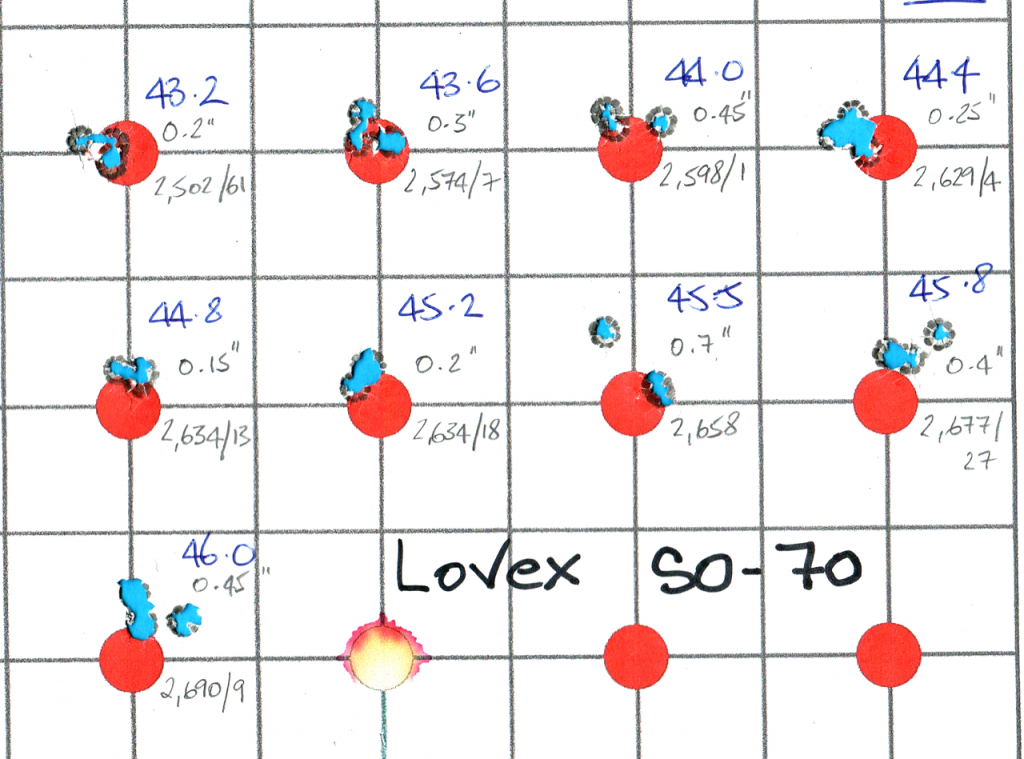
Off to the range in mid-December to be greeted by a cold day, the light fading shortly after midday when I got round to this powder. Shoot the starting load group of 43.2gn, a nice quarter-inch cloverleaf, but the Labradar says only 2,488 fps average MV – nearly 200 fps down on what QL predicted. Shoot the next charge’s batch and another nice group, but the Labradar has tripped out because of low battery level. (I assumed my well used rechargeable power pack was failing, but it was eventually found that the external power feed cable was defective, apparently a common fault.) So, go home and ponder this one result. I searched further for SO70 data without success, then had a ‘light bulb moment’ – I still had my Accurate Smokeless Powder Reloading Guide Number 2 published back in 2000. Look up 4350 in the 7mm-08 with the 160gn Nosler Partition in R-P brass at 2.800” for the SAAMI chamber, maximum load 46.0gn for 2,630 fps MV (24-inch test barrel) at 49,400 CUP (SAAMI 7-08 max is 52,000 in this form of chamber pressure measurement). ‘Compressed load’ said the table’s notes.
That would take me to c.47gn plus with my longer custom chamber, but I doubted I’d get that much into the Lapua case even with the shallower bullet seating. So, load up the first two batches again, and add four more at the top end to get me to 46.0gn – which was indeed compressed – and I stopped there. Back out again a week later and shoot the nine batches off. As you can see, there are some excellent groups, many single-figure ES values too, but MVs remained low. My top load of 46gn produced 2,690 fps, nearly 100 fps down on the 45gn H4350 benchmark value of 2,784 fps, and the lowest velocity from any powder tried. Remember, I’m using these powders in a rifle with a 31-inch barrel!
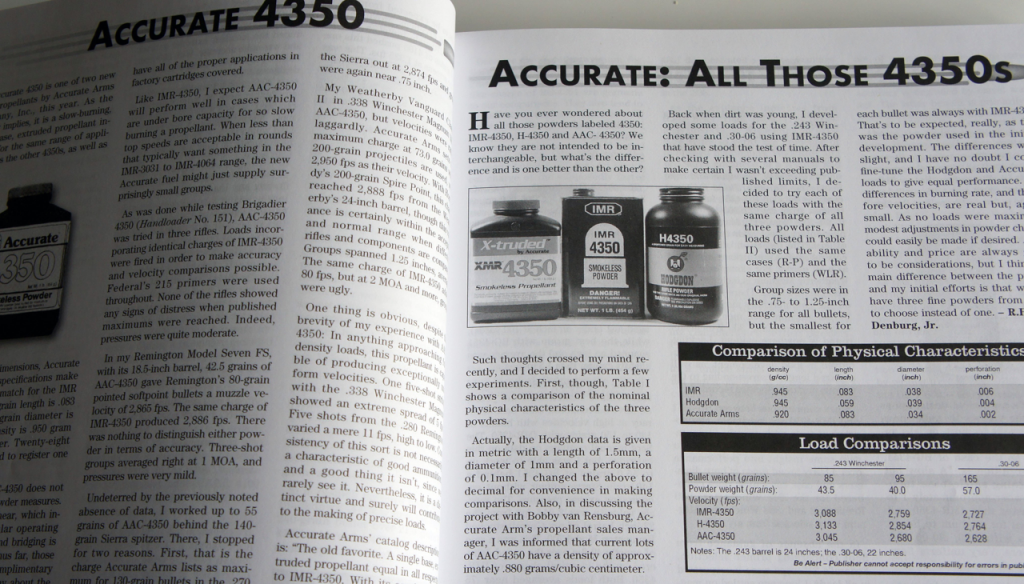
I mentioned the old pre-Western Powders XMR4350 was known to be slower burning than the IMR or Hodgdon variants, so that took me to a reprinted ‘Propellant Profiles’ feature from a 2003 Handloader magazine issue (from Wolfe Publishing Propellant Profiles Sixth Edition, a compilation of reprinted Handloader Propellant Profiles from between the years of 1966 and 2016). There, I dug out a short piece called ‘All those 4350s’ by R H VanDenburgh Jr which compared IMR, Hodgdon, and XMR versions across four loads, two bullets each in 243 Win and 30-06. H4350 gave the highest MVs in every case; XMR the lowest. Compared to H4350 results, one 243 load was 88 fps down, the other 174 fps. Both 30-06 combinations saw XMR MV ‘deficits’ of around 130 fps compared to H4350 for same weight charges. My SO70 45gn charge weight was ~150 fps down on the same weight of H4350 in the longer-barrel 7mm-08 – Bingo! Today’s SO70 is apparently unchanged from the [Accurate Arms] XMR4350 branded version of a quarter century ago, at least in this respect, and is apparently much slower burning than H4350, presumably taking it into IMR-4831 territory. It’ll almost certainly work well in suitable 4350-using cartridges with more capacious cases than the 7mm-08. Conversely, that is likely to make it at best a mediocre choice for 4350 loving cartridges with less case capacity than the 7-08, thinking here particularly of 6.5mm Creedmoor, so SO70’s faster burning stablemate SO65, reported on in Part 2, is a superior choice for this class of cartridge. This is the second Lovex SO grade which I’ve found to be apparently much slower burning than Explosia, the Lovex manufacturer believes as the same comments applied to SO65. It’ll be interesting to see if the pattern recurs with SO60 and SO62 which I’ll try as H4895 and VarGet alternatives respectively in 223. Returning to the 7mm-08 Rem, SO70 was one powder where my noticeably higher capacity Winchester brass would have been a better choice than the Lapua products used in these tests. An extra 1.0-1.5gn powder which they would have held without excessive charge compression would have been very welcome and helped push MVs up to acceptable levels. (Carrying this thought over to 6.5mm Creedmoor, use higher capacity Hornady brass rather than Lapua, Norma, or Peterson if you must choose SO70).
Shows Promise, needs More Work
Well then, nine possible H4350-class powders covered …! What does that leave? There are three other extruded powders, two new or newish (Viht N555 and IMR-4451 Enduron) and one well-established grade, but which has only recently been reintroduced into the UK after a long absence (Norma 204). All performed competently, and are definitely suitable 4350 alternatives, but don’t fall within the previously applied classifications. I’ll cover them in the next part of this saga, likewise our second benchmark Hodgdon powder, ‘spherical’ H414, with two possible Reach-compliant alternatives from Ramshot.
